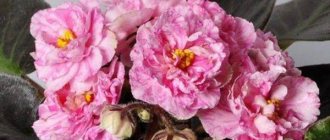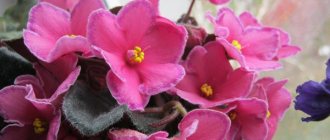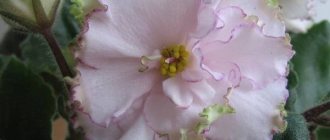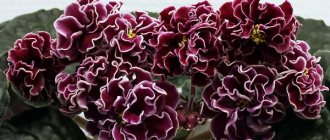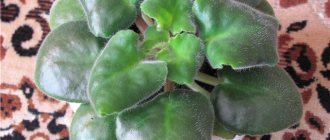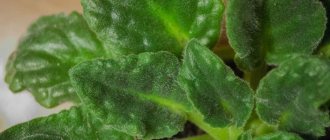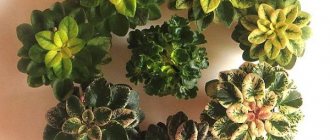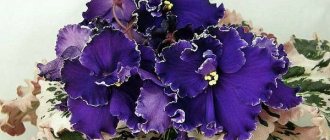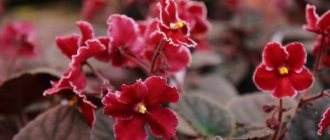The author of the variety is Boris Mikhailovich Makuni . He is rightfully considered one of the founders of Russian violet selection.
He worked together with his wife Tatyana Nikolaevna. Since the middle of the last century, the creative tandem has developed more than 300 different varieties of Saintpaulia.
The varieties of the Makuni spouses
made a splash at exhibitions in the USA and Japan. In addition to practical work on crossing and growing violets, Makuni devoted a lot of work to writing articles and books on care and propagation. Makuni are the founders of the Russian school of breeding Uzambara violets. Many talented Russian breeders studied with them.
Violet Magic Night (B. Makuni)
Violet Magic Night.
Systematic position
Order : Clear-flowered (Lamiáles).
Family : Gesneriaceae.
Genus : Hybrid Saintpaulia (Saintpaulia hybrida).
Photo and description of the variety
The Saintpaulia variety Magic Night is characterized by double dark blue flowers strewn with pink specks.
Sometimes the spots are snow-white. The flowers are small, but there are a lot of them in each bloom.
Saintpaulia leaves:
- Rich green color;
- Velvet;
- With serrated edge;
- Standard.
The rosette is quite large and dense.
Medicinal properties of violet tricolor
Tricolor violet has medicinal properties, as its composition is extraordinary. It contains salicylic acid, ascorbic acid, essential oils, tannins and much more. Such a wealth of substances provides effective assistance in treating diseases.
Actions on the human body:
- Diuretic.
- Expectorant.
- Anti-inflammatory.
- Sweatshop.
- Heals wounds.
- Relieves itching and irritation.
- Cleanses the blood.
- Calming.
Important: You can make decoctions, infusions or teas from the flower. Infusions of pansies are recommended to treat diseases of the respiratory system, for example, bronchial diseases, pneumonia, tuberculosis.
Drops made from the plant can even cure sinusitis. Tricolor violet works great against itching after mosquito bites in young children.
We recommend watching a video about the medicinal properties of Pansies (tricolor violets):
Home care
Proper watering and fertilizing
The Magic Night variety loves watering. When the substrate dries out, it quickly drops its leaves and flower stalks. The frequency of watering depends on many factors :
- Light intensity;
- Air temperature and humidity;
- Age and life stage of the violet;
- The material from which the pot is made, and much more.
Many violets prefer watering from above.
It must be remembered that the size of the intervals between waterings is important , and not the volume of water poured. The violet needs to be watered when the top layer of the substrate has dried, and this happens in different plants at different intervals.
Water the violets with soft, settled water at a temperature of 23-25 degrees.
It is preferable to water Saintpaulia from above, using :
- Syringes with a volume of 150-200 ml;
- Or a small watering can with a long spout.
Important! Liquid fertilizers are optimal for violets. This type of fertilizer is easier to dose.
These devices will provide a thin stream of water and protect the leaves from moisture and the soil from erosion.
Occasionally, you can water the violets by immersing them 1/3 of the height of the pot in water, but it is better not to abuse this method , since with such watering there is a high risk of root rotting.
Basic rules for feeding violets:
- Young plants need nitrogen;
- Phosphorus stimulates the formation of a large number of buds;
- During flowering, plants need potassium;
- We introduce fertilizing from above, with water for irrigation;
- The optimal choice is a complex fertilizer containing chelated forms of the main macro and microelements;
- Often, instead of fertilizers, transshipment will be more beneficial for the plant.
Lighting and temperature
The brighter the room, the brighter, larger the flowers and the greater their number.
Important! Avoid direct sunlight! They cause burns on leaves and flowers. Choose northern or northeastern, northwestern window sills for violets to live.
In winter, violets require additional lighting.
The temperature in the room where violets live should be about 20-220 . Children and cuttings need a temperature of 24-250 and higher humidity. Temperatures that drop below +130 and rise to +290 can seriously harm the violet.
Effect of air humidity
Saintpaulias in their natural environment prefer river banks and the surroundings of waterfalls; moisture in the air is very important for them .
A humidity level of 60-70% will be favorable. With regular watering and a comfortable temperature, adult plants feel good even at lower humidity (30-40%).
In winter, in conditions of air dried by radiators, the humidity level is maintained artificially . You can use a humidifier or improvised means.
Soil requirements
The soil must have the following properties :
- Ease;
- Air permeability;
- Moisture capacity;
- Sufficient amount of macro and microelements;
- pH 5.5-6.5 (slightly acidic);
- Absence of pathogens and pests;
- The presence of living beneficial microflora.
Important! Most store-bought potting mixes are not suitable for violets. Black mixtures made from lowland peat are especially dangerous.
Soil for violets can be bought at a flower shop.
An example of the composition of a mixture for planting Saintpaulia:
- High-moor peat and Greenword soil – 5 parts;
- Vermiculite (perlite) – 2 parts;
- Sphagnum (coconut fiber) – 2 parts;
- Nutritious soil – 1 part;
- Adding crushed charcoal and dolomite flour will further improve the quality of the mixture.
This recipe can serve as a starting point for your experiments. The main thing is that the finished mixture is light and does not cake.
Pruning and hygiene
In order for the grown rosette of Saintpaulia to be beautiful and neat, it is subjected to shaping . Usually the top three tiers of leaves are left. Lower leaves can be removed. Removed:
- Peduncles with wilted flowers;
- Yellowed, diseased, damaged leaves.
By removing the lower leaves, we gradually open the violet stem. is sprinkled with fresh soil as necessary .
Give the violets in your collection a weekly inspection. Each pot is picked up, the outlet is inspected, checking the need :
- Glaze;
- Adding substrate;
- Removing leaves and flower stalks
Also, when examining, pay attention to the following signs :
- Parasites (cobwebs, wilting);
- And diseases (wet areas, spots).
Inspect violets for pests and diseases.
Dust, accumulating in the fleecy leaves of violets, harms the plant. It is washed off under the tap , protecting the soil with a bag, tying it on the pot so that water does not fall on the soil.
Attention! Each leaf is washed separately under a thin stream of warm water.
Reproduction methods
The best results are obtained by vegetative propagation by rooting leaves .
Transplant rules, rejuvenation
to replant violets of the Magic Night variety in the following cases:
- Violet grows in this substrate for 2 or more years;
- Roots appeared from the drainage hole;
- The plant withers, although watering is optimal;
- The soil in the pot has become sour;
- You have decided to rejuvenate or deepen the plant.
We carry out all manipulations during transplantation carefully. Violets are delicate creatures .
Transfer procedure:
- Remove the root ball from the pot. (It is better if the substrate is dried);
- Remove most of the old soil;
- Trim off excessively long roots, as well as old, damaged roots;
- Place the violet in the new substrate;
- After 24 hours, water the plant and, if necessary, add soil.
Important! The pot size remains the same!
The magical night, which has reached the age of 2.5-3 years, needs to be rejuvenated . If you leave the plant for a longer period, you will not see cap flowering. To rejuvenate the plant, the “head” (the growing point and 2 tiers of leaves) is cut off and rooted in a greenhouse.
The old violet needs to be rejuvenated.
Violet Blue Danube
This variety was bred in Russia and is one of the brightest representatives among violets.
It has wavy, matte leaves with small green teeth.
The flowers are large, reach five centimeters in diameter, and are blue in color. It blooms very profusely. This variety loves well-lit growing areas and is demanding of moisture.
The duration of flowering depends very much on maintaining the correct temperature.
This indoor flower Violet Blue Danube will be a wonderful addition to the collection of any amateur gardener. It looks beautiful on the windowsill and has valuable decorative qualities.
Propagation of Saintpaulia Blue Danube
To propagate Saintpaulia, leaf cuttings are used. It can be propagated all year round. Cuttings for propagation are cut with a sharp knife or blade four centimeters long.
- Next, they are placed in a jar of water and wait for the first roots to appear.
- They use only settled water, put paper on top of the jar and tie it with thread.
- Holes are made in this paper through which the cuttings are lowered and should touch the water.
- And within three weeks the plants begin to develop roots.
- Afterwards they should be transplanted into pots with the following soil mixture, which should consist of sand, peat and pine soil.
Pots with plants should be placed in a well-lit and warm place and covered with a jar.
For propagation, they also use the method of dividing the uterine bushes. After dividing, they are transplanted into separate pots. The pots are chosen to be small in size. The soil mixture for planting is prepared from pitch, turf, deciduous and humus soil.
Until the plant takes root well, it is watered with warm, well-settled water and periodically fed with fertilizers. Place in well-lit places.
Caring for Saintpaulia Blue Danube
Saintpaulias are placed in areas of rooms with good lighting, since this is a light-loving flower.
The most suitable temperature for growing is twenty degrees Celsius, at this temperature the plant blooms the longest.
For irrigation, use water that is four degrees warmer than the room temperature. When watering, water entering the leaves is unacceptable. When water gets on the leaves of a plant, spots form. Water moderately.
The water should sit for at least a day before watering. In the summer, it makes sense to feed the plant with a solution of cow manure.
The plant is replanted once a year. During replanting, rotten and damaged roots should be removed. The sections are treated with charcoal.
These plants should not be placed in drafts. If little light enters the room, the plant may not bloom. When placing a flower, you should pay attention to ensure that its leaves do not touch various objects, much less other plants.
If it touches other objects, its leaves may rot. Therefore, it is advisable to keep Saintpaulia at a distance from intensively growing plants.
Features of flowering, growth and reproduction
Magic Night grows well on a shelf, but still prefers a window .
How long does it take to grow an adult plant?
, 10-12 months will pass between the rooting of the baby and the first buds . When growing this variety from cuttings, you will need to wait 2-3 weeks longer.
Reproduction methods and features
are transmitted very well during vegetative propagation .
The procedure for propagating violets by leaf cuttings is known to everyone from a school biology textbook:
- For rooting you need a small glass (80 ml) with drainage;
- We cut or carefully break off a healthy leaf from the second tier;
- We root the cuttings into the soil with the addition of cultivators (perlite, vermiculite);
- Cover with another glass or put in a bag;
- We are expecting the baby to arrive in a couple of weeks.
Leaf cuttings can be rooted in boiled water and then transplanted into soil .
Features of flowering in hot and cool conditions
Temperature conditions do not affect the flowering of the variety.
What do flower stalks look like?
Peduncles are quite strong and dark-colored. When flowering they do not fall, they firmly bear the weight of the flowers .
The peduncles of violets are very strong.
Is it possible to achieve cap flowering?
The variety Magic Night has cap flowering . The cap is formed by voluminous double flowers and due to the large number of peduncles.
Bud lifespan
Each flower then fades approximately 6-8 days after the bud opens.
Violet Jolly Sun Chaser
Description of the silhouette
Young violets independently and easily pack their leaf plates into a problem-free rosette silhouette configuration with fairly dense filling and a checkerboard design.
Compact bushes of semi-miniature format remain for the most part in the middle of the typological gradation, but under optimal conditions their sizes can approach the border of the standard format.
Medium-sized leaves of a pointed oval structure with a slightly wavy, shiny surface texture have fine, angularly outlined jagged contours and slightly pressed graphics of veins with an enlarged central axis of emerald tone.
The color of the upper side of the plates is distinguished by a rich color of darkened green. The reverse side of the leaves becomes tinted with a reddish coating as they age.
The corollas of the small variety are painted with smooth transitions of white and various shades of yellow . At the very beginning of the opening of the buds, the color of the petals has a bright yellow tone, lightening with age to almost white in some places.
As the corollas age, their petals again acquire a more intense yellowish tint, reaching light brown edges. The petals have a delicate texture and wavy contours; their outer side may have a pinkish coating.
INTERESTING! The distinctive features of the flowers of this variety are the extremely terry texture of the structure and the slight curling of the petals from the center downwards, which together creates some disheveled corollas. From the mass of constantly forming smallish buds, a cap of impressive volume can be obtained.
Sports
The violet was not noted to display sporting characteristics in specimens.
Details of development and flowering stages
The easy care of Saintpaulia and its independence in development should attract the attention of violet growers, but for unknown reasons the variety is quite rare in collections.
Development in home collections
Among the positive varietal traits of violets are:
- independence in creating a semi-miniature socket form;
- decorative volumes of flower hats;
- increasing the flowering effect with each wave;
- strong flower stalks.
CAREFULLY! There are no significant deficiencies noted in the variety, although in low light the leaves may lift upward. In addition, the flower stalks have a considerable length and can wriggle like snakes, but do not lose strength.
Breeding specifics
Reproduction can be carried out exclusively vegetatively:
- children from leaves;
- layering from a mature plant.
Pedicel structure
The variety is characterized by strong but long peduncles.
Flowering form
The voluminous caps of Saintpaulia appear almost immediately.
Durability of whisks
The flowers are decorative for about a month .
Reviews
Anatol. “I have a weakness for yellow varieties, so the violet “Jolly Sun Chaser” is one of my favorites. I try not to overfeed her so that she doesn’t lose her small shape.”
